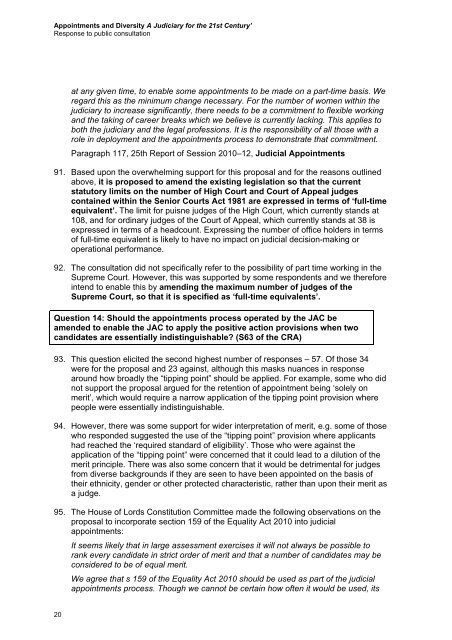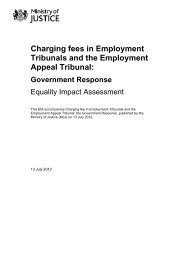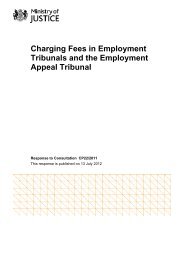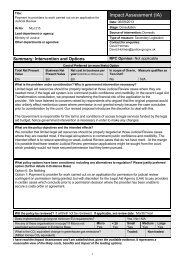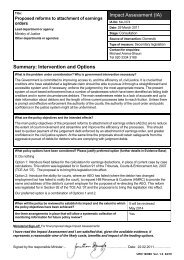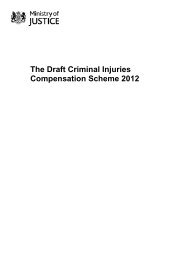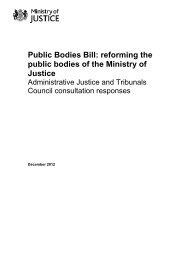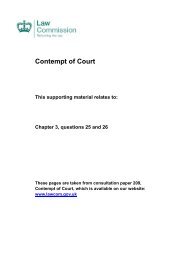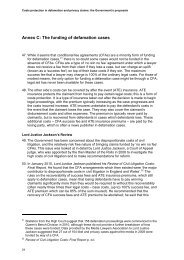Appointments and Diversity 'A Judiciary for the ... - Ministry of Justice
Appointments and Diversity 'A Judiciary for the ... - Ministry of Justice
Appointments and Diversity 'A Judiciary for the ... - Ministry of Justice
You also want an ePaper? Increase the reach of your titles
YUMPU automatically turns print PDFs into web optimized ePapers that Google loves.
<strong>Appointments</strong> <strong>and</strong> <strong>Diversity</strong> A <strong>Judiciary</strong> <strong>for</strong> <strong>the</strong> 21st Century’<br />
Response to public consultation<br />
at any given time, to enable some appointments to be made on a part-time basis. We<br />
regard this as <strong>the</strong> minimum change necessary. For <strong>the</strong> number <strong>of</strong> women within <strong>the</strong><br />
judiciary to increase significantly, <strong>the</strong>re needs to be a commitment to flexible working<br />
<strong>and</strong> <strong>the</strong> taking <strong>of</strong> career breaks which we believe is currently lacking. This applies to<br />
both <strong>the</strong> judiciary <strong>and</strong> <strong>the</strong> legal pr<strong>of</strong>essions. It is <strong>the</strong> responsibility <strong>of</strong> all those with a<br />
role in deployment <strong>and</strong> <strong>the</strong> appointments process to demonstrate that commitment.<br />
Paragraph 117, 25th Report <strong>of</strong> Session 2010–12, Judicial <strong>Appointments</strong><br />
91. Based upon <strong>the</strong> overwhelming support <strong>for</strong> this proposal <strong>and</strong> <strong>for</strong> <strong>the</strong> reasons outlined<br />
above, it is proposed to amend <strong>the</strong> existing legislation so that <strong>the</strong> current<br />
statutory limits on <strong>the</strong> number <strong>of</strong> High Court <strong>and</strong> Court <strong>of</strong> Appeal judges<br />
contained within <strong>the</strong> Senior Courts Act 1981 are expressed in terms <strong>of</strong> ‘full-time<br />
equivalent’. The limit <strong>for</strong> puisne judges <strong>of</strong> <strong>the</strong> High Court, which currently st<strong>and</strong>s at<br />
108, <strong>and</strong> <strong>for</strong> ordinary judges <strong>of</strong> <strong>the</strong> Court <strong>of</strong> Appeal, which currently st<strong>and</strong>s at 38 is<br />
expressed in terms <strong>of</strong> a headcount. Expressing <strong>the</strong> number <strong>of</strong> <strong>of</strong>fice holders in terms<br />
<strong>of</strong> full-time equivalent is likely to have no impact on judicial decision-making or<br />
operational per<strong>for</strong>mance.<br />
92. The consultation did not specifically refer to <strong>the</strong> possibility <strong>of</strong> part time working in <strong>the</strong><br />
Supreme Court. However, this was supported by some respondents <strong>and</strong> we <strong>the</strong>re<strong>for</strong>e<br />
intend to enable this by amending <strong>the</strong> maximum number <strong>of</strong> judges <strong>of</strong> <strong>the</strong><br />
Supreme Court, so that it is specified as ‘full-time equivalents’.<br />
Question 14: Should <strong>the</strong> appointments process operated by <strong>the</strong> JAC be<br />
amended to enable <strong>the</strong> JAC to apply <strong>the</strong> positive action provisions when two<br />
c<strong>and</strong>idates are essentially indistinguishable (S63 <strong>of</strong> <strong>the</strong> CRA)<br />
93. This question elicited <strong>the</strong> second highest number <strong>of</strong> responses – 57. Of those 34<br />
were <strong>for</strong> <strong>the</strong> proposal <strong>and</strong> 23 against, although this masks nuances in response<br />
around how broadly <strong>the</strong> “tipping point” should be applied. For example, some who did<br />
not support <strong>the</strong> proposal argued <strong>for</strong> <strong>the</strong> retention <strong>of</strong> appointment being ‘solely on<br />
merit’, which would require a narrow application <strong>of</strong> <strong>the</strong> tipping point provision where<br />
people were essentially indistinguishable.<br />
94. However, <strong>the</strong>re was some support <strong>for</strong> wider interpretation <strong>of</strong> merit, e.g. some <strong>of</strong> those<br />
who responded suggested <strong>the</strong> use <strong>of</strong> <strong>the</strong> “tipping point” provision where applicants<br />
had reached <strong>the</strong> ‘required st<strong>and</strong>ard <strong>of</strong> eligibility’. Those who were against <strong>the</strong><br />
application <strong>of</strong> <strong>the</strong> “tipping point” were concerned that it could lead to a dilution <strong>of</strong> <strong>the</strong><br />
merit principle. There was also some concern that it would be detrimental <strong>for</strong> judges<br />
from diverse backgrounds if <strong>the</strong>y are seen to have been appointed on <strong>the</strong> basis <strong>of</strong><br />
<strong>the</strong>ir ethnicity, gender or o<strong>the</strong>r protected characteristic, ra<strong>the</strong>r than upon <strong>the</strong>ir merit as<br />
a judge.<br />
95. The House <strong>of</strong> Lords Constitution Committee made <strong>the</strong> following observations on <strong>the</strong><br />
proposal to incorporate section 159 <strong>of</strong> <strong>the</strong> Equality Act 2010 into judicial<br />
appointments:<br />
It seems likely that in large assessment exercises it will not always be possible to<br />
rank every c<strong>and</strong>idate in strict order <strong>of</strong> merit <strong>and</strong> that a number <strong>of</strong> c<strong>and</strong>idates may be<br />
considered to be <strong>of</strong> equal merit.<br />
We agree that s 159 <strong>of</strong> <strong>the</strong> Equality Act 2010 should be used as part <strong>of</strong> <strong>the</strong> judicial<br />
appointments process. Though we cannot be certain how <strong>of</strong>ten it would be used, its<br />
20


